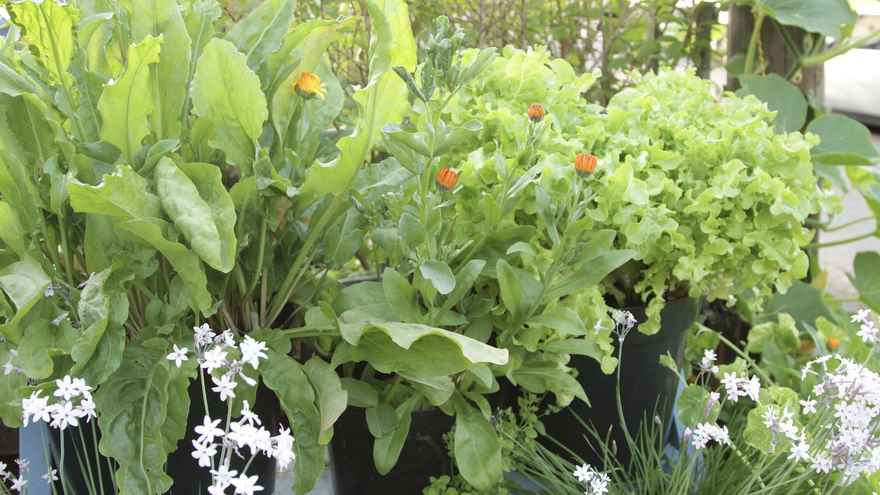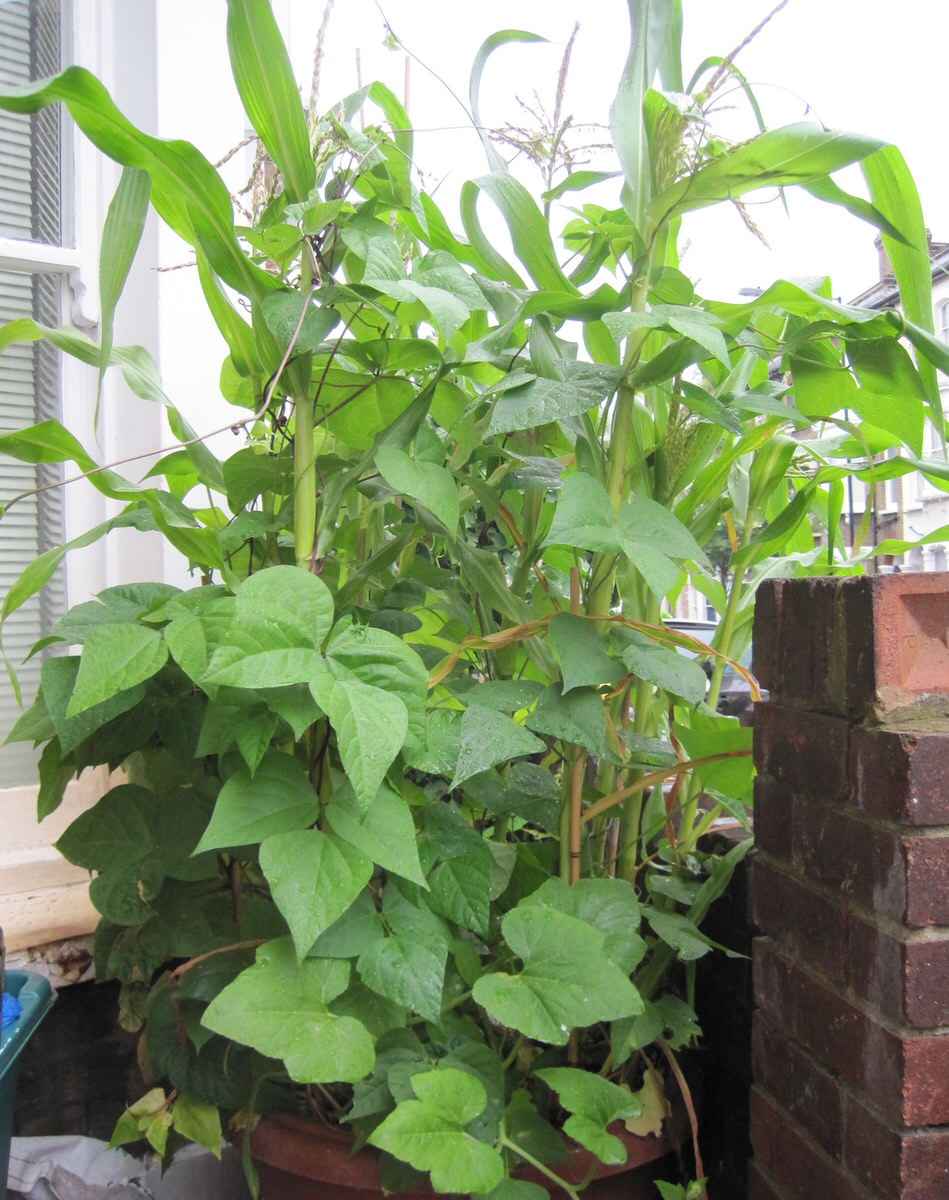Does companion planting in containers work?

Companion planting is a technique where different plants are grown near each other for mutual benefit. It is reputed to enhance growth, deter pests, and improve pollination among plants. For example, marigolds are often planted amongst vegetables to repel aphids. There is a lot of anecdotal evidence that this works in the ground, and some scientific evidence to back it up.
But does it work in containers? The short answer is that, yes, it can sometimes. But it's important to be aware that things are not as clear cut when choosing how to use companion planting in containers at your home, because:-
- In containers, plants have access to less water, food and root space than in the ground. This results in more intense competition for resources between plants. It is quite common for one plant to struggle and the other to take over. This means that planting different plants together in the same container doesn't always work as well as in the ground. It also means that companion planting strategies are more likely to work in larger containers.
- The best known companion combinations were developed in a part of the world where the climate and conditions suit that combination. However, the same combination may not work as well in the balcony or patio in the town and climate where you live.
Examples of Well Known Companion Combinations
The Three Sisters
One of the most famous companion plantings is the Three Sisters: growing squash, climbing beans and sweetcorn together. The corn provides height and structure, the beans climb up the corn and the squash leaves shade the soil, helping to prevent the growth of weeds. It’s a brilliant way of growing, developed by Native American Indians hundreds of years ago - and is extremely effective when grown in the ground in the American climate.
However, due to limited space in a pot, it is much harder to get all the plants to grow well, particularly in the UK climate.
It’s still a fun one to try - I love how the beans climb the sweetcorn… Just don’t expect a bumper harvest. Here is my attempt back when I lived in London. The foliage grew OK - but apart from a few beans, I didn't get much to eat from it. Others I've spoken to have had similar experiences.

My attempt at growing the Three Sisters in a pot outside my London flat.
Tomatoes and Basil
As an example of how climate influences the choice of which companion combinations will work, consider tomatoes and basil. In warmer parts of the world where basil grows well outside this is potentially a great combo for containers - as basil is reputed to repel some pests like aphids and also helps shade the soil. Also, basil and tomatoes are both excellent choices for container gardens. But, where I live in the north England, it's simply too cold to grow basil outside for most of the year so this combination is not an option.
Applying the Principles of Companion Planting more Broadly
As well as looking for specific combinations that will grow well in the same container, another approach is apply the general principles of companion planting across different containers to achieve similar benefits. This is the way I apply the idea of companion planting to my container garden.
For example, you can:-
- Grow a wide diversity of plants. Many pests find their host plants by sight. By growing more variety you make it harder for them to find those plants they most like to eat. It also reduces the risk that you will lose a lot of plants in one go, because many pests are quite plant specific.
- Add in some strong smelling plants like garlic, chives, rosemary and sage. Some pests use smell to find their preferred plants, so this can help to confuse them.
- Grow flowers to support pollinating insects. Great choices for the container garden include things like borage, dill, pot marigold and herbs like chives, sage and rosemary.
In other words, plants do not have to be grown in the same container to achieve many of the benefits of companion planting.

My front yard: by growing a wide diversity of plants contributes to a healthy garden.
Is companion planting the best strategy to reduce pests?
Over the years, I’ve seen a number of articles that convey the impression that companion planting is the solution to pest problems in the container garden. I think this is misleading. Companion planting is just one way to help prevent pests. More broadly, the principle of diversity and growing different plants is also highly recommended for overall garden health. However, other things like good watering, and using a high quality, microbial active potting will usually do more to reduce overall pest problems.
Your Turn - which plant combinations do work well in the same container?
For companion planting to be relevant to container gardening, we need to learn more about which combinations work best in containers.
If you’ve tried any combinations that have worked well in your containers, I’d love to hear from you in the comments.
Hopefully over time we can develop a list of companion combinations that are well suited to container gardeners.

5 comments
Nasturtiums Mark, nasturtiums! The best companion plant I know. I grow them everywhere. . You can plant them in the same pot but I prefer to plant them in whatever 6 inch upwards pot I am not using and butt it up against the pot I want it to 'companion '. They love rubbish soil so plant them in last year's old soil, I often just plant it into the soil left in the pot from last year, they love that. Butterflies love laying their eggs on them and as long as you have a lot the caterpillars don't wander off of them and eat your veg. You need a lot of them to make it work and I love the look of all the little pots surrounding the bigger pots. Sometimes if there is room I stand them in the big pots. Yes, I am a little bit mad about nasturtiums!
I am pleased you wrote about the Three Sisters. I have tried to grow this so many times and failed, it is good to know others have had the same problem.
Thank you for writing your blog, I love reading it.
Ellie
Two of the best references I use on companion planting are Companion Plants and How to Use Them by Helen Philbrick and Richard B. Gregg. ISBN 978-178250-286-9. Floresbooks.ca.uk. It is a new edition of work done in the 1943 when a first attempt was made to collect information on plants that did well as companions, and those that seemed to display antagonism.
"It is possible to improve a carrot crop by alternating two rows of carrots with one row of flax. Or one or two plants of flax to a row of potatoes will remarkably reduce the number of Colorado potato beetles." Just note that the whole flax plant is known to be poisonous, especially the immature seed pods.
Carrots Love Tomatoes, Secrets of Companion Planting for Successful Gardening by Louise Riot, 1975, updated in 1998. ISBN 978-1-58017-027-7
"Sweet Peppers—The general requirement of sweet peppers are surprisingly like those of basil, so plant them together. Sweet peppers also grow well with okra, and since they are very brittle plants, the okra , growing taller, serves as a windbreak."
I have experimented with companion planting in my sub-irritated (SIPs) plastic containers for many years on my both of my roofs. Onions with lettuce, leeks with carrots, beets with bush bean, onions or kohlrabi and cucumbers with radishes, peas or beans. When planting radishes with cucumbers let the radishes go to seed.
I’ve had the most success with growing small, nonspreading herbs like chives and basil with veg in containers. Some herbs like sage and oregano quickly take over the pot and are better off in their own pots. Small flowers like pansies also work well. I experiment with mixing veggies types with varying success. Chard and cucumbers worked well.
I'm looking at more containers this year as I'm expecting to be moving house by the autumn and would like to take as many plants as I can with me. Also, I'm probably looking at a much smaller garden so will need more creative solutions. Regarding companion planting, it occurs to me that apart from pot space limitations, there is the possibility of differing water requirements. Do you think that another solution might be separate pots placed together?
I have attempted to companion plant nasturtiums with tomato, but very soon the tomato was so large it blocked all the sun from the nasturtiums. I like Ellie's idea of a separate pot but next to the tomato, that way it can be moved around. Thank you for the blog post, companion planting is one of the things I've been struggling with.
Leave a comment